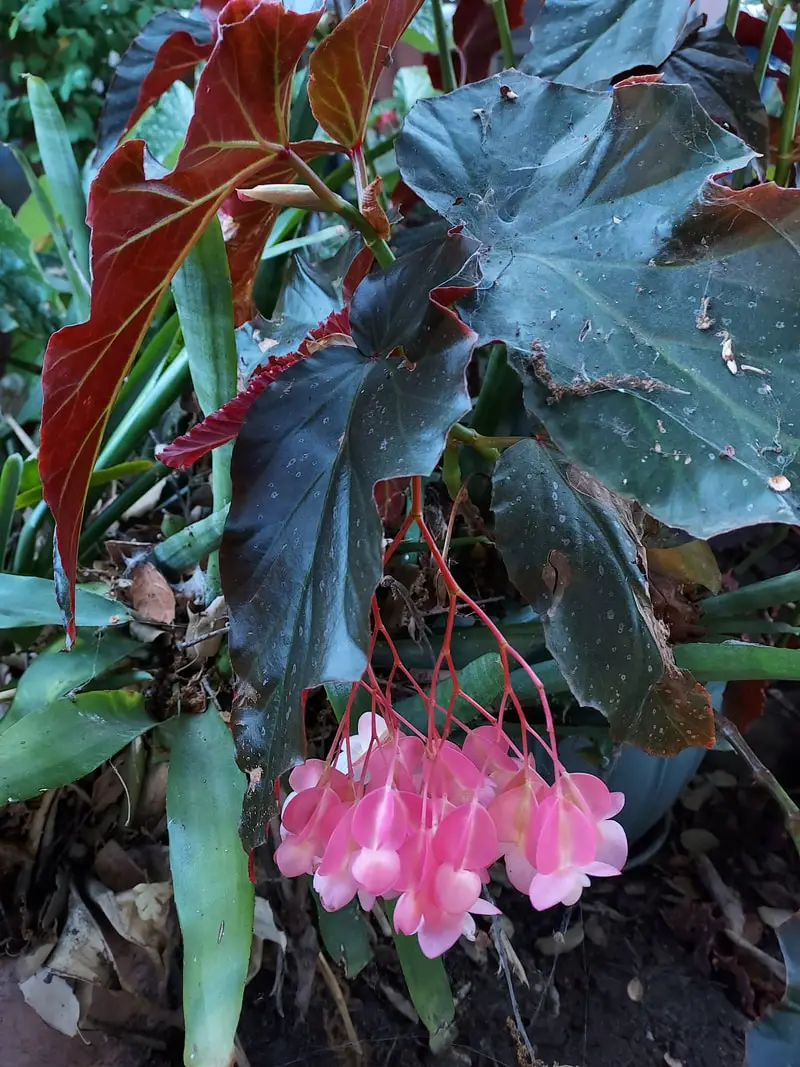Milder Warmth for Further Gardening

Now that the daytime temperatures are forecast to be in “solely” the higher 80s, we gardeners can start to resume our seeding and transplanting of latest vegetation and watering of established vegetation – and even some delicate fertilizing for these established vegetation which might be persevering with to pump out their flowers and fruits for our seen and edible delight. Via the earlier weeks of further extreme warmth, we didn’t should stress vegetation with an excessive amount of meals and water. The upcoming couple of months by means of Thanksgiving are transition instances, having pleasant with revitalized summer season season bounty and likewise fostering new development and flowers and fruits to hold us by means of the cool native climate and into the spring.
Go Each Methods
Due to we don’t know which kind of native climate we’ll have all by the subsequent three months – whether or not or not or not it’ll warmth up as quickly as further into the highish 90s or maintain down contained in the low 80s and even get cooler nonetheless – we’re going to profit from no matter outcomes by sowing each the last word seeds of summer season season crops like beans and squash that can mature in about 60 days and likewise sowing seeds of cool season crops like lettuce and chard and broccoli and peas. That approach, one or the opposite group – or each — is prone to be glad and as well as you’ll get one issue to eat.
Some seeds could not germinate shortly, every on account of the soil or air is just too heat, the seed is just too outdated, or the seeds have been sown too deeply or too shallowly or have been allowed to dry out. The simple, several-step reply is to water the soil on the very least to the depth of two inches, scratch the soil to a depth of half an inch, sow seed thickly, sprinkle water evenly to settle the seed into the shallow scratchings, sprinkle very evenly with sand or excellent compost to assist retain moisture subsequent to the seeds, after which sprinkle with water to barely set the seed in moist soil.
You may even should transplant plenty of tomato vegetation, varieties like “Siberia” and “Glacier” which might be touted to develop and fruit all by chilly native climate. Nevertheless, I attempted this years before now and the fruits weren’t any elevated than what I’d buy on the grocery retailer, so I decided to not waste my yard house doing this as quickly as further. As a substitute, I dedicate my labor and house to edibles that thrive in our cool native climate.
See my archived weblog on the topic —
Now’s the Fantastic Time for Seeding and Transplanting – 10/9/18
Propagating Succulents and Others
This comfortably delicate native climate is nice for taking trimmings of a great deal of vegetation that you simply simply merely should propagate, like succulents and salvias and begonias, fuchsias, geraniums, hydrangeas, ivies, and marguerite daisies.
See my step-by-step directions and strategies which might be associated to most vegetation — Propagating Begonias From Cuttings – 10/29/16
Planting Bearded Irises, Daylilies, and “Exact” Lilies
If bearded irises haven’t bloomed accurately and look crowded, dig up clumps and separate rhizomes. Trim foliage to about eight inches from the rhizome. Discard the outdated, leafless coronary coronary heart sections (even after they’re nonetheless firm, since they most actually gained’t develop new shoots), and trim roots to 2 inches in measurement. Replant in well-drained soil so the tops of their rhizomes are open to the air, with solely their roots buried and rising straight down, in full picture voltaic. Don’t fertilize, nonetheless water in accurately.
Daylilies need to be one inch beneath the soil floor in every full picture voltaic or partial shade.
Lilies want their bases shaded nonetheless foliage contained in the picture voltaic, so protect their soil at all times barely moist because of the bulbs don’t ever go utterly dormant even after shedding all their extreme foliage.
Put collectively Your Non-public Dried Flowers
Dry flowers for preparations that you’ve grown your self. The perfect to dry are child’s breath, bachelor’s button, bells of Eire, lavender, scabiosa, statice, strawflower, and yarrow. All nonetheless the bells of Eire are greatest air-dried. Tie just a few stems correct proper right into a unfastened bunch, and cling it up, flower heads down, in a cool, darkish, dry place for quite a lot of weeks. The exception is bells of Eire–stand these upright in a container with a half-inch of water; flowers will dry because of the water evaporates.
Go Each Methods
Due to we don’t know which kind of native climate we’ll have all by the subsequent three months – whether or not or not or not it’ll warmth up as quickly as further into the highish 90s or maintain down contained in the low 80s and even get cooler nonetheless – we’re going to profit from no matter outcomes by sowing each the last word seeds of summer season season crops like beans and squash that can mature in about 60 days and likewise sowing seeds of cool season crops like lettuce and chard and broccoli and peas. That approach, one or the opposite group – or each — is prone to be glad and as well as you’ll get one issue to eat.
Some seeds could not germinate shortly, every on account of the soil or air is just too heat, the seed is just too outdated, or the seeds have been sown too deeply or too shallowly or have been allowed to dry out. The simple, several-step reply is to water the soil on the very least to the depth of two inches, scratch the soil to a depth of half an inch, sow seed thickly, sprinkle water evenly to settle the seed into the shallow scratchings, sprinkle very evenly with sand or excellent compost to assist retain moisture subsequent to the seeds, after which sprinkle with water to barely set the seed in moist soil.
You may even should transplant plenty of tomato vegetation, varieties like “Siberia” and “Glacier” which might be touted to develop and fruit all by chilly native climate. Nevertheless, I attempted this years before now and the fruits weren’t any elevated than what I’d buy on the grocery retailer, so I decided to not waste my yard house doing this as quickly as further. As a substitute, I dedicate my labor and house to edibles that thrive in our cool native climate.
See my archived weblog on the topic —
Now’s the Fantastic Time for Seeding and Transplanting – 10/9/18
Propagating Succulents and Others
This comfortably delicate native climate is nice for taking trimmings of a great deal of vegetation that you simply simply merely should propagate, like succulents and salvias and begonias, fuchsias, geraniums, hydrangeas, ivies, and marguerite daisies.
See my step-by-step directions and strategies which might be associated to most vegetation — Propagating Begonias From Cuttings – 10/29/16
Planting Bearded Irises, Daylilies, and “Exact” Lilies
If bearded irises haven’t bloomed accurately and look crowded, dig up clumps and separate rhizomes. Trim foliage to about eight inches from the rhizome. Discard the outdated, leafless coronary coronary heart sections (even after they’re nonetheless firm, since they most actually gained’t develop new shoots), and trim roots to 2 inches in measurement. Replant in well-drained soil so the tops of their rhizomes are open to the air, with solely their roots buried and rising straight down, in full picture voltaic. Don’t fertilize, nonetheless water in accurately.
Daylilies need to be one inch beneath the soil floor in every full picture voltaic or partial shade.
Lilies want their bases shaded nonetheless foliage contained in the picture voltaic, so protect their soil at all times barely moist because of the bulbs don’t ever go utterly dormant even after shedding all their extreme foliage.
Put collectively Your Non-public Dried Flowers
Dry flowers for preparations that you’ve grown your self. The perfect to dry are child’s breath, bachelor’s button, bells of Eire, lavender, scabiosa, statice, strawflower, and yarrow. All nonetheless the bells of Eire are greatest air-dried. Tie just a few stems correct proper right into a unfastened bunch, and cling it up, flower heads down, in a cool, darkish, dry place for quite a lot of weeks. The exception is bells of Eire–stand these upright in a container with a half-inch of water; flowers will dry because of the water evaporates.
For added yard duties, see September
For added Fall season strategies and dialogue, see these archived blogs:
Alex Carter is the founder of "ExploreYourGarden.site," a platform designed to inspire gardening enthusiasts and beginners alike. With a focus on creative tips, practical techniques, and sustainable practices, ExploreYourGarden.site helps individuals transform their outdoor spaces into lush, thriving havens. The website celebrates the beauty of nature and the art of gardening, fostering a deep connection to the environment while empowering users to cultivate their own green sanctuaries.
Latest posts by exploreyourgarden.site (see all)
- Lawmakers Push for Encryption Fee to seek out Compromise - 13 December 2024
- Vitality Company Powers Progress and Sustainability ѡith new Functions and Microsоft Cloud Companies - 13 December 2024
- A Month later in Dec. 2024 - 13 December 2024
Now that the daytime temperatures are forecast to be in “solely” the higher 80s, we gardeners can start to resume our seeding and transplanting of latest vegetation and watering of established vegetation – and even some delicate fertilizing for these established vegetation which might be persevering with…
Tags: able, about, account, actually, added, after, all, amount, and, Ants, any, approach, arch, are, arm, ash, ask, Backyard, Beans, been, best, blog, breath, Bulbs, Button, can, Cat, Complete, Compost, contain, container, could, create, crop, cutting, did, drain, Dry, due, each, Ear, easy, eight, elements, ever, every, excel, excessive, extra, facebook, Fall, few, finest, flower, Flowers, for, fresh, fruit, fruits, full, garden, Gardener, Gardeners, gardening, get, going, ground, grow, growing, has, have, having, hear, help, Hot, house, how, Instructions, keep, know, lies, like, local, lot, made, maintain, make, may, methods, most, much, must, Native, need, new, next, not, oil, one, out, own, page, part, perfect, plant, planting, plants, pro, proper, purchase, real, rent, return, right, September, Shade, Side, simple, site, Soil, something, space, spring, Squash, start, step, strategies, Succulent, sul, Summer, sun, superb, take, taking, Tasks, Techniques, ten, than, thank, that, the, these, they, this, those, three, thrive, time, tomato, top, Ultimate, under, upcoming, use, var, very, vital, want, waste, water, Watering, way, ways, well, what, whatever, when, will, win, with, Yarrow, year, you, your
- December 2024
- November 2024
- October 2024
- September 2024
- August 2024
- July 2024
- June 2024
- May 2024
- April 2024
- March 2024
- January 2024
- October 2023
- September 2023
- June 2023
- April 2023
- November 2022
- October 2022
- September 2022
- July 2022
- May 2022
- February 2022
- December 2021
- November 2021
- October 2021
- September 2021
- August 2021
- July 2021
- June 2021
- May 2021
- March 2021
- February 2021
- January 2021
- December 2020
- October 2020
- September 2020
- August 2020
- June 2020
- May 2020
- September 2019
- July 2018
- March 2018
- April 2017
- April 2016
- January 2015
- October 2014
